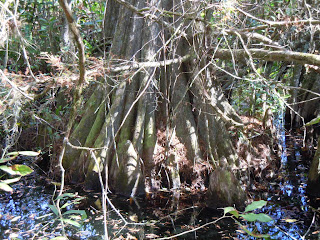I learned a lot from the class, University Colloquium. It touched on many world and environmental subjects, such the global warming, greenhouse gases, agriculture all over the world, fishing and the wastes we dump into waters, fossil fuels, and the political issues with all of these subjects.
My most memorable moments for the class will be the field trips and service learning time. The field trips to ECHO, Corkscrew Swamp Sanctuary, and Downtown Fort Myers were far for me to drive to, but very enjoyable. My trip to Ding Darling was very long and did not end up working out. I will revisit there when I have the time and money. My service learning time was spent doing something I have never done before, research on rainfall correlated to plant growth in the Six-Mile Cypress Slough, and I got to see things I have never seen before, like the swamp rabbit. Besides the hard work to dredge through water, mud, and tangled water plants the service learning time was positive.
I also really enjoyed listening to the cd’s and reading the book, The Weather Makers. It touched on many different subjects with regards to carbon dioxide and the environment, and it will be a great research tool for my future classes at FGCU since I am majoring in Environmental Engineering.
I, however, did not enjoy reading the excerpts from the University Colloquium book or State of the World book. The articles seemed to be long, drawn out and I did not seem to get as much out of them, compared to The Weather Makers. Because I did not gain much of an interest in the excerpts and articles, it made it very more difficult for me to write the discussion posts and journal entries about them. There was a lot of writing for this class- much more than I had anticipated. Although, I did like writing the research paper because I could convey my thoughts and ideas about carbon dioxide emissions and the roles people play. I have started working on the final project and have enjoyed it so far as well because I get to convey my ideas.
The class gave me the opportunity to create my own blog, which is my first ever blog, and I used the opportunity to get some of my friends to join so they can read about the things I’ve been learning. The videos we watched during this class were all good, entertaining, and informative, except A Crude Awakening: The Oil Crash (it was boring and hard for me to keep my concentration).
Overall, I had a great learning experience from the University Colloquium class and will be able to use the information I obtained from this class in my future endeavors.
Thanks Professor Eric Muldoon:
~Max G.







